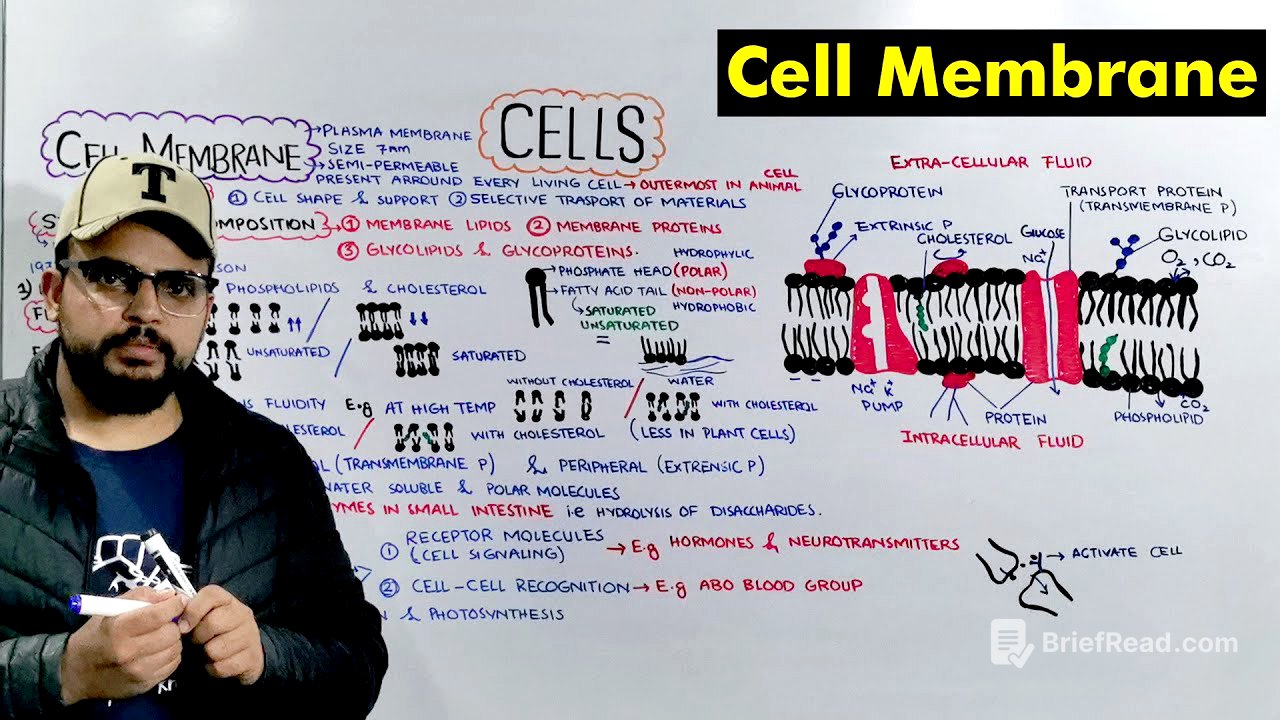TLDR;
This lecture provides a detailed explanation of the cell membrane, also known as the plasma membrane or cell surface membrane. It covers the structure, composition, and functions of the cell membrane, emphasizing its semi-permeable nature and importance in maintaining the cellular environment. The fluid mosaic model, proposed by Singer and Nicholson, is discussed, along with the roles of phospholipids, proteins, cholesterol, glycolipids, and glycoproteins. The lecture also explains how factors like temperature and fatty acid composition affect membrane fluidity and how cholesterol helps maintain homeostasis.
- Cell membrane is semi-permeable and surrounds every living cell.
- The fluid mosaic model explains the structure of the cell membrane.
- Cholesterol maintains the fluidity of the cell membrane.
Introduction to Cell Membrane [0:02]
The cell membrane, also known as the plasma membrane or cell surface membrane, is a semi-permeable boundary present around every living cell. It selectively allows molecules to enter or exit the cell, maintaining the internal environment. In animal cells, it is the outermost boundary, while in plant cells, bacteria, and fungi, it lies inside the cell wall. The cell membrane provides support and mechanical strength to the cell.
Structure and Composition: Fluid Mosaic Model [2:17]
In 1972, Singer and Nicholson proposed the fluid mosaic model to describe the structure of the cell membrane. This model illustrates the membrane's fluid nature, where molecules can move easily. The cell membrane consists of a phospholipid bilayer with proteins embedded within it, creating a mosaic pattern. The phospholipid bilayer is composed of polar, hydrophilic heads and nonpolar, hydrophobic fatty acid tails. Saturated fatty acids result in straight tails, while unsaturated fatty acids create bent tails due to double or triple bonds.
Phospholipids and Their Arrangement [4:00]
The phospholipid bilayer is arranged with the hydrophilic heads facing the watery environments inside and outside the cell, while the hydrophobic tails face inward, away from water. This arrangement is crucial for maintaining the membrane's integrity and preventing water-soluble molecules from freely passing through. The polar heads interact with the intracellular and extracellular fluids, ensuring proper enzymatic activity near the membrane.
Proteins in the Cell Membrane [7:03]
Proteins are embedded within the phospholipid bilayer in a mosaic pattern. These proteins include integral proteins (also known as transmembrane or transport proteins) and peripheral proteins. The hydrophobic oils merge with each other, preventing polar molecules from entering. Cholesterol is also present within the membrane. Glycolipids and glycoproteins are formed when carbohydrate molecules attach to lipids and proteins, respectively.
Cholesterol and Membrane Fluidity [9:27]
Cholesterol plays a vital role in maintaining membrane fluidity. Factors such as temperature and the composition of fatty acids affect fluidity. High temperatures increase fluidity as phospholipid molecules move away from each other, while low temperatures decrease fluidity as molecules come closer. Unsaturated fatty acids increase fluidity due to their bent structure, which prevents tight packing. Cholesterol acts as a buffer, preventing excessive increases or decreases in fluidity, thus maintaining homeostasis.
Factors Affecting Fluidity: Temperature and Fatty Acids [10:41]
High temperatures cause phospholipid molecules to move apart, increasing fluidity, while low temperatures cause them to come together, decreasing fluidity. Unsaturated fatty acids, with their bent structures, prevent close packing and increase fluidity. Saturated fatty acids allow for tighter packing, reducing fluidity. Cholesterol maintains fluidity by preventing molecules from moving too far apart at high temperatures and preventing them from packing too tightly at low temperatures.
Importance of Maintaining Fluidity [14:20]
Maintaining the right level of fluidity is essential for cell function. It ensures that the cell membrane is neither too open nor too closed, allowing nonpolar molecules like oxygen and carbon dioxide to pass through easily. This balance is crucial for various cellular processes.
Membrane Proteins: Types and Functions [15:24]
Membrane proteins are of two types: integral (transmembrane) and peripheral. Integral proteins facilitate the transport of large or polar molecules, such as glucose, across the membrane. Peripheral proteins attach to the membrane and connect to microtubules, forming a cytoskeleton that maintains the cell's structure and withstands external pressure.
Glycolipids and Glycoproteins: Functions [18:46]
Glycolipids (carbohydrate + lipid) and glycoproteins (carbohydrate + protein) are involved in cell signaling and cell-to-cell recognition. They act as receptor molecules, activating cellular activities in response to hormones and neurotransmitters. Additionally, they enable immune cells to recognize and differentiate between different cell types in the body.
Cell Signaling and Cell Recognition [19:04]
Glycolipids and glycoproteins facilitate cell signaling by enabling cells to receive and respond to signals from hormones and neurotransmitters. They also play a crucial role in cell-to-cell recognition, allowing immune cells to identify and interact with other cells based on specific patterns on their surfaces. This recognition is vital for immune responses and maintaining tissue integrity.
Additional Functions of Cell Membranes [21:12]
Cell membranes in organelles like chloroplasts and mitochondria have specific functions. In chloroplasts, the membrane contains pigments that aid in photosynthesis. In mitochondria, the membrane is involved in respiration. Cell membranes also facilitate the transport of chemicals into and out of the cell.









